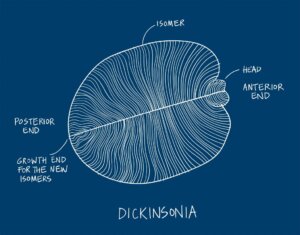World's First Animal Discovered


Written and verified by the vet Eugenio Fernández Suárez
Discovering the world’s first animal has always been of interest to scientists, but it’s often difficult to prove which fossil remains belong to extinct animals and which don’t. However, this hasn’t prevented what experts have to declared to be the world’s first animal: Dickinsonia.
Dickinsonia, the world’s first animal
Dickinsonia is one of the creatures corresponding to the Ediacaran period, which began no fewer than 635 million years ago. Fossils of extreme rarity come from this period, to which we can add Dickinsonia.
Given the appearance of these living creatures, it’s difficult to classify them. Lacking limbs, bones, or other features that many animals have, many fossils like Dickinsonia end up being classified as fungi or lichens.
Dickinsonia has even been defined as a kind of coral or worm, or a jellyfish. It hasn’t been until now that a team of scientists has discovered the identity of this being.

How do we know it’s the world’s first animal?
There’s something that distinguishes the world’s first animal from other findings: this fossil contains cholesterol, a molecule that only animals have and that makes Dickinsonia the oldest animal, being dated at 542 million years.
The presence of cholesterol doesn’t raise suspicions about the identity of this animal, but rather guarantees them. The presence of cholesterol makes Dickinsonia the world’s first animal without a doubt. Or rather, the first animal in the world that we know of, as many species haven’t yet been discovered.
The truth is that it has always been suspected that Dickinsonia was an animal, because several fossilized specimens seemed to indicate growth and movement corresponding to one of these living beings. But in 2018, it was confirmed, allowing us to discover new characteristics in our most ancient ancestors.

How was this finding made?
The appearance of these animals makes them particularly difficult to classify; Dickinsonia is a creature up to a meter (3.3 feet) in diameter and oval in shape, with a body divided into segments. It was discovered by Ben Dickinson, in whose honor it was named over 70 years ago.
The fossils were found at a height of 100 meters (330 feet), in a cliff on the White Sea, northwest of Russia, in the habitat of the brown bear. In order to obtain the samples, the scientists had to climb down through the rock and extract sediments, in a task somewhere between canyoning and paleontology.
The use of biomarkers such as cholesterol opens the door to studying other fossils of this type, and so another fossilized organism may well beat Dickinsonia’s claim to be the world’s first animal.
It’s believed that this animal was an aquatic species, which spent most of its time anchored to the sediments in a similar way to oysters or even lichens, through hyphae. It’s believed that they had a kind of keratin coating, which has allowed them to fossilize well. Despite the latest news we’ve brought you this time, it’s clear that there are still many mysteries to be solved about the oldest animals to walk the planet.
Discovering the world’s first animal has always been of interest to scientists, but it’s often difficult to prove which fossil remains belong to extinct animals and which don’t. However, this hasn’t prevented what experts have to declared to be the world’s first animal: Dickinsonia.
Dickinsonia, the world’s first animal
Dickinsonia is one of the creatures corresponding to the Ediacaran period, which began no fewer than 635 million years ago. Fossils of extreme rarity come from this period, to which we can add Dickinsonia.
Given the appearance of these living creatures, it’s difficult to classify them. Lacking limbs, bones, or other features that many animals have, many fossils like Dickinsonia end up being classified as fungi or lichens.
Dickinsonia has even been defined as a kind of coral or worm, or a jellyfish. It hasn’t been until now that a team of scientists has discovered the identity of this being.

How do we know it’s the world’s first animal?
There’s something that distinguishes the world’s first animal from other findings: this fossil contains cholesterol, a molecule that only animals have and that makes Dickinsonia the oldest animal, being dated at 542 million years.
The presence of cholesterol doesn’t raise suspicions about the identity of this animal, but rather guarantees them. The presence of cholesterol makes Dickinsonia the world’s first animal without a doubt. Or rather, the first animal in the world that we know of, as many species haven’t yet been discovered.
The truth is that it has always been suspected that Dickinsonia was an animal, because several fossilized specimens seemed to indicate growth and movement corresponding to one of these living beings. But in 2018, it was confirmed, allowing us to discover new characteristics in our most ancient ancestors.

How was this finding made?
The appearance of these animals makes them particularly difficult to classify; Dickinsonia is a creature up to a meter (3.3 feet) in diameter and oval in shape, with a body divided into segments. It was discovered by Ben Dickinson, in whose honor it was named over 70 years ago.
The fossils were found at a height of 100 meters (330 feet), in a cliff on the White Sea, northwest of Russia, in the habitat of the brown bear. In order to obtain the samples, the scientists had to climb down through the rock and extract sediments, in a task somewhere between canyoning and paleontology.
The use of biomarkers such as cholesterol opens the door to studying other fossils of this type, and so another fossilized organism may well beat Dickinsonia’s claim to be the world’s first animal.
It’s believed that this animal was an aquatic species, which spent most of its time anchored to the sediments in a similar way to oysters or even lichens, through hyphae. It’s believed that they had a kind of keratin coating, which has allowed them to fossilize well. Despite the latest news we’ve brought you this time, it’s clear that there are still many mysteries to be solved about the oldest animals to walk the planet.
All cited sources were thoroughly reviewed by our team to ensure their quality, reliability, currency, and validity. The bibliography of this article was considered reliable and of academic or scientific accuracy.
Bobrovskiy, I., Hope, J. M., Ivantsov, A., Nettersheim, B. J., Hallmann, C., & Brocks, J. J. (2018). Ancient steroids establish the Ediacaran fossil Dickinsonia as one of the earliest animals. Science, 361(6408), 1246-1249.
This text is provided for informational purposes only and does not replace consultation with a professional. If in doubt, consult your specialist.








